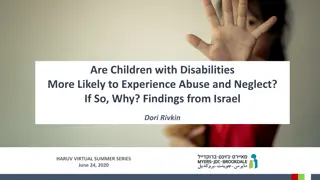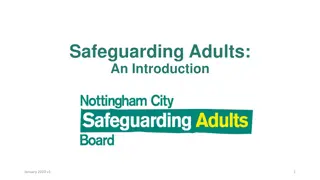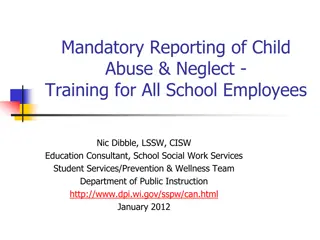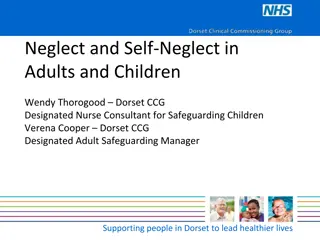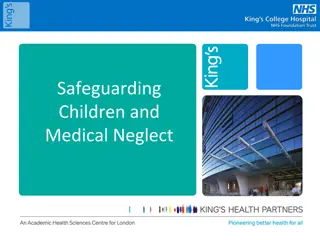Advocating Against Child Abuse and Neglect: Your Essential Role
Understanding the importance of advocating for children facing abuse and neglect is crucial for all individuals, regardless of their position. Learning about child abuse, recognizing signs, mandatory reporting laws, and knowing how to take action are essential components discussed in this informative content. The role of advocating, early intervention, mandatory reporting, and the significance of documentation in addressing child abuse are highlighted to emphasize the shared responsibility in protecting vulnerable children.
Download Presentation

Please find below an Image/Link to download the presentation.
The content on the website is provided AS IS for your information and personal use only. It may not be sold, licensed, or shared on other websites without obtaining consent from the author. Download presentation by click this link. If you encounter any issues during the download, it is possible that the publisher has removed the file from their server.
E N D
Presentation Transcript
Child Abuse & Neglect Advocating for Children What s Your Role?
Why learn about child abuse? Child abuse & neglect are a reality Some myths exist about child abuse Child abuse occurs across our community/region, and we address it at Children s Nebraska Regardless of your position within Children s continuum of care (Hospital, Specialty, Home Health, CP Clinics), it s important to know some facts & processes
Importance of Advocacy and Early Intervention Children are at a power disadvantage Adverse Childhood Experiences (ACE) study https://www.theannainstitute.org/Finding%20Your%20ACE%20Scor e.pdf (ACE questionnaire)
Mandatory Reporting Per Nebraska law, ALL persons are mandatory reporters! If you suspect a child is being abused or neglected, you are required by law to report. Failure to do so may result in criminal charges. Child Protective Services hotline #s: Nebraska: 1-800-652-1999 Iowa: 1-800-362-2178
Your Role at Childrens Notify Social Work Notify one of the following: Manager, Supervisor, Attending, or PCP as appropriate Notify Security if there are immediate safety concerns Document! What to do if you re unsure about a situation Review child abuse policies on PolicyStat for guidance Bring it up to your manager and/or a Social Worker trust your gut!
What if you are not a direct care team member? Plan of action: Identify patient if able (name, MRN, location, etc.) Voalte the Social Worker assigned to your area immediately or call the hospital operator and ask for Social Work Call Security if there is an immediate safety concern (Ext. 5300) Document where you are able
Importance of Documentation Document, document, document! Write exactly what you see & hear Factual, nonjudgmental language. You can use quotes to document statements of concern along with actions & events. Child abuse cases are handled as a team and no one has to address it alone. Accurate documentation from all team members is extremely important.
Childrens Advocacy Team (CAT) CAT is a multidisciplinary team (MDs, APRNs, RNs, SWs) Dr. Suzanne Haney is the CAT Medical Director Purpose of the team is to: Identify & assess for concerns of abuse & neglect Refer for Services Education Coordinating with external investigative agencies Child Protective Services (CPS) Not an emergency responder Assesses risk to child Needs a Court order to remove a child Provides services with goal of rehabilitating & reunifying the family Law Enforcement Responds to imminent danger/emergency Investigates the crime Can place a protective hold on child CAT facilitates a weekly CAT Meeting to review child abuse and neglect cases
Childrens Advocacy Team (CAT) Members Suzanne Haney M.D. Jessica Boger PCMSW, PLMHP Kristi Aldridge APRN Lynn Fullenkamp M.D. Laurie Berglund APRN Jairren Flodine LCSW
Types of Child Abuse and Neglect Cases in 2023 (473 cases - primary concern identified) 31% Physical Abuse 41% Neglect (Includes Failure to Thrive & Emotional Abuse) 14% Sexual Abuse Under 1% Drug Exposed Newborn
Severity of CPS Cases in 2023 3 CAT consults resulting in fatality 8 cases of abusive head trauma 22 Accidental Ingestions 67% of abuse/neglect occurs within the child s home 40% of cases were under the age of 3 (188 children)
What Constitutes Abuse & Neglect? Abuse: 1. 2. Physical unexplained, non-accidental injury in a child. Emotional caregivers constantly reject a child, place blame on them, or expose them to violence. Sexual Any sexual act, practice, contact, or interaction in which the child has been used by an adult. 3. Neglect: 1. Emotional Child suffers due to caregiver not providing chances to feel loved, wanted, secure & worthy. Physical Caregiver does not provide basic needs (i.e. food, clothing, heat in winter) or a safe/sanitary living environment for a child. Also includes a lack of safe supervision & failure to follow medical recommendations. 2.
Case examples Bruising What is the history or the story? Grab marks Is the history consistent with the injury? Is the injury consistent with child s age? Active toddler vs immobile infant
Case examples Marks from physical contact
How Does This Happen? Very few people intend to cause harm to a child Consider family circumstances & risk factors No one risk factor can predict child abuse & neglect Every family has their own history & stressors that we do not fully know outside of our interactions in the medical setting
Risk Factors & Family Stressors Child illness Other family illness Isolation/Minimal supports Limited resources Finances/Missed work Limited insight/problem solving or parenting skills Language and Cultural Barriers Child behavioral concerns Mental health/post partum reactions Substance abuse Relationship concerns/Interpersonal violence
The Role of Social Work Identify and address risk & rising risk factors Social workers use various tools & theories to gather pertinent information and assess Psychosocial assessments, depression/anxiety screening Systems theory If concerns continue or are significant for safety, Social Work collaborates with the medical team to make a report.
What Happens Next? Social Work reports all discernible child abuse situations Social Work can support & assist other team members in making reports Other supportive referrals & follow up Child s placement may change (i.e. relative care or foster care) or remain the same with services & safety plans put in place
It Takes a Village Bottom line call us! With questions on a specific situation or if you want to process a situation further If you continue to think or worry about a situation you witnessed If you need help understanding more about child abuse/neglect or Social Work s role at Children s
Other Social Work Interventions Crisis intervention Legal concerns/guardianship issues/visitation Financial concerns Transportation concerns Food insecurity Child abuse and neglect Help to engage the family with the medical team & plan Coordinate care across the Children s continuum Psychosocial assessments Mental health assessment & referral Emotional support needs (new diagnosis/chronic illness) Connect family to state and/or federal programs they may qualify for Connect family to community resources and services Liaison to community organizations and schools
If you have questions for Social Work, please call 402-955-5418 and you will be connected to a Social Worker.





